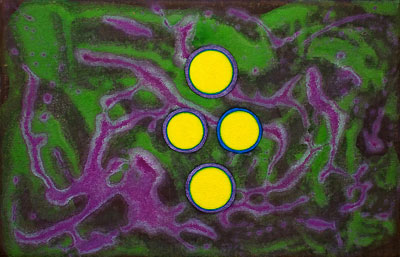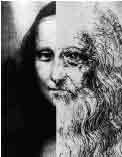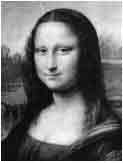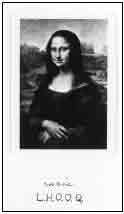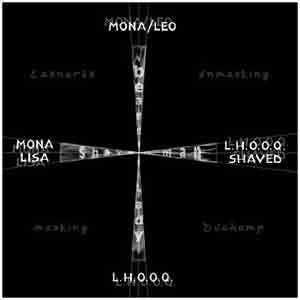L.H.O.O.Q. (Mona-Lisa-with-a-mustache)
sitemap
drawings
paintings 1 2 3 4 5 5 a b c -
- A B . . . . . . . new
installations
projects
reviews
|
Erich Kuby (1910-2005) |
Erich Kuby (1910-2005) |
L.H.O.O.Q. (Mona-Lisa-with-a-mustache)
Antoinette LaFarge
The Bearded Lady and the Shaven Man -
Mona Lisa, meet Mona/Leo*
There is no discontinuity between the Bachelor Machine and the Bride.
Marcel Duchamp[1]
In 1919, Marcel Duchamp drew a mustache and goatee on a reproduction of the Mona Lisa and called the resulting work L.H.O.O.Q. (Fig. 1).[2] Not quite three-quarters of a century after Duchamp’s graffito came what I think of as the sequel: Lillian Schwartz’s discovery that the chief model for the Mona Lisa was Leonardo da Vinci himself. Both acts are backward- looking in that their most immediate effect was to redefine the Mona Lisa itself. At the same time, both are prophetic in the way they project major shifts in the grounds of art as a system of knowledge.
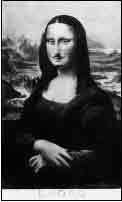
Fig. 1. Detail of L.H.O.O.Q., a 1919 work by Marcel Duchamp that is an altered collotype of the Mona Lisa.
On the simplest level, Duchamp’s banal gesture nominated the Mona Lisa as a man. More exactly, Duchamp created a rudimentary sort of mask that reads instantly as male but does not even pretend to conceal the woman behind the mask. In a sense, L.H.O.O.Q. is an artificial hermaphrodite, an image of a woman with that most superficial and nonfunctional characteristic of maleness, a mustache. (The beard is superfluous to the effect of L.H.O.O.Q., and in one version of the piece does not appear at all.)[3]
At the same time, L.H.O.O.Q. is not a hermaphrodite at all but an intensified or exposed woman. The Mona Lisa’s mustache can be read as an abbreviated, transposed beard and thus as a metaphor for her actual “beard,” or pubic hair. By transferring Mona Lisa’s beard from her pubic region to her face, Duchamp conceptually strips her naked: her clothes no longer conceal what they’re supposed to conceal. She is another embodiment of the central figure in Duchamp’s most famous work, The Bride Stripped Bare by Her Bachelors, Even (also known as the Large Glass).
Duchamp thus creates a kind of visual analog in which the face stands in for the sexual organs instead of merely alluding to them, as the lips normally allude to labia.[4] The mustache-over-lips structure directly echoes the pubic-hair-over-labia structure. In a sense, the entire woman has been vertically condensed into an amorphous package of flesh—a kind of head-to-genitals morph, to use an analogy from the digital world. Furthermore, this flesh package is recondensed through the title into one of the standard tags used to present women as nonindividuals: hot ass.[5]
I am not trying to present a full reading of L.H.O.O.Q. here; rather, for reasons which will become clear later, I am consciously restricting my reading to a limited field that centers on issues of gender, sexuality, and identity. In short, my concern is with L.H.O.O.Q. as an instance of the Bearded Lady archetype. That any discussion of L.H.O.O.Q. can take off in many other directions is a tribute to the richness of Duchamp’s gesture, minimal as to form but maximal as to content.[6] Not the least of Duchamp’s achievements with L.H.O.O.Q. was to bring the Mona Lisa back from the dead. By attacking its iconic status, he removed it from historical time and brought it into the present, the only place where art can be experienced. L.H.O.O.Q. was actually an act of rescue (even if only temporarily) rather than an act of desecration. However, it did not rescue the Mona Lisa as a traditional painting, an object of primarily visual pleasure. The crude mustache functions as a scratch on the Renaissance picture window; it insistently draws our attention to itself and thus irreparably damages the illusion of which it fails to be a part.
What L.H.O.O.Q. did do, on the other hand, was to nominate the petrified painting as a center of activity: a subject of debate, parody, paradox, criticism, thought, and reinvention. L.H.O.O.Q. simultaneously documents Duchamp’s thought processes and implicitly invites further interventions. As such, it is a paradigm of late modernist art; one could even make a case that it is postmodern, a point I will return to later. To construe it as an attempt at self-expression—a major objective of early twentieth century artists—is to miss the point. Still less is L.H.O.O.Q. a demonstration of mastery in Arthur Danto’s sense, in which the work of art serves merely as a pretext for showing off one’s mastercraftsmanship.[7] In fact, insofar as the mustache ended up by serving as Duchamp’s signature for L.H.O.O.Q.—that is, the mark that made it unmistakably a work by Duchamp—it points the way to the signature art of the 1950s and ’60s. By “signature art” I mean artworks that serve merely as a pretext for showing off the artist’s style instead of his or her mastery, so that the style serves to make the actual signature redundant.
By declaring open season on the Mona Lisa, Duchamp laid the groundwork for Lillian Schwartz. However, where Duchamp’s gesture was deliberate, Schwartz’s discovery was essentially accidental, a byproduct of her project to compare and combine images of artists with digitized versions of their work, especially self-portraits.[8] When she was asked to test her colleague Gerard Holzmann’s computer program to do this, she began with an obvious pair, the most famous artist and painting in Western art. When the Mona Lisa and Leonardo’s only known self-portrait were aligned and juxtaposed on-screen at the same scale, Schwartz was struck by the extraordinary congruences in facial features between the two portraits. Such highly individual measurements as the distance between the inner corners of the eyes matched so closely that Schwartz concluded the similarity could not be a matter of chance; ergo, Leonardo must have been the main model for the Mona Lisa.
I use the qualifier “main” because Schwartz concludes that Leonardo began the portrait using a female model before turning the painting into a disguised self-portrait. X-rays of the Mona Lisa reveal a second face hidden under the surface that does not match the one familiar to our eyes. Using her comparative techniques, Lillian Schwartz has shown that this earlier, hidden portrait does match a separate cartoon drawing Leonardo executed of Isabella, Duchess of Aragon, before he began work on the Mona Lisa. However, neither the hidden X-ray face nor the cartoon drawing of Isabella matches up in toto to the visible Mona Lisa—or to the Leonardo self-portrait.[9]
Where Duchamp put the Mona Lisa’s sexuality under tension, mocking the female icon without wholly undoing the gender identity between image and (presumed) model, Schwartz appears to explode it. Image and model simultaneously merge (two aspects of a single human being) and separate (male model, female image). This doubleness is epitomized in Schwartz’s Mona/Leo (also known, in an early working title, as It Is I; Fig. 2), a 1987 image that shows the right half of Mona Lisa’s face butted up to the left half of Leonardo’s self-portrait.[10] Although Mona/Leo appears to be an artwork (at least, Schwartz treats it as such), I feel it is a kind of metonymy for the primary artwork, which is to say, Schwartz’s demonstration of the identity of Mona Lisa and Leonardo. For the sake of simplicity in the following discussion, I will refer to this entire project, including both the discovery and the images Schwartz generated to demonstrate her discovery, under the rubric “Mona/Leo.”
Fig. 2. Mona/Leo, a 1987 computer generated image by Lillian F. Schwartz in which the left side of a 1512 Leonardo da Vinci self-portrait is matched to the right side of Mona Lisa’s face.
It would be a mistake to think that Mona/Leo “solved” the mystery presented by the Mona Lisa and extended by Duchamp. A hundred years ago, it would indeed have been profoundly shocking if scholars had been able to prove that the most famous image of beautiful, mysterious womanhood in Western art, the very icon of the Eternal Feminine, was also a man. Today, though, after almost five centuries of uncertainty and speculation about the “real” identity of Mona Lisa, larger cultural shifts in our understanding of gender and identity have conspired to rob this moment of much of its drama. Certainly, Schwartz’s discovery does not reduce Mona Lisa to a mere masquerade, a drag show, a footnote to Leonardo’s biography. Indeed, it is striking that Mona Lisa the woman-revealed-as-mask refuses to disappear completely into Leonardo the man. So entrenched is the Mona Lisa in our psychic vocabulary that one finds oneself wondering whether the historical person we think of as “Leonardo” was not a man at all but— fantastic as it sounds—the male impersonation of a woman we now know only by her self-portrait.
Far from solving anything, Mona/Leo introduced new tensions into the dialogue between Mona Lisa and L.H.O.O.Q. It functions as a kind of mirror image of L.H.O.O.Q. in that it reverses the polarity of Duchamp’s act: it converts the male-masked female (L.H.O.O.Q.) into a female-masked male (Mona Lisa).[11]
Like L.H.O.O.Q., Mona/Leo is a version of the Bearded Lady. As such both refer us back to the Mona Lisa, positing her as the Bearded Lady’s twin, the Shaven Man. Historically, this archetype has never been as prominent as the Bearded Lady—there being, for example, no Shaven Men in freak shows. We see its operation mainly in those subtle cultural shifts ordaining that in one generation men shall be clean-shaven and in another bearded, such that where the two overlap (as in the England of the Roundheads and Cavaliers, or America ca. 1968) there will be open hostility between them. Perhaps the Shaven Man has remained in the shadows of art in part because he functions as a disguised form of male narcissism. Leonardo offers us the Mona Lisa as a desire decoy; his real object is to give himself room to indulge in self-love. If the Shaven Man is exposed as not-a-woman, the secrecy of pleasure and the pleasure of secrecy both disappear.[12]
Fig. 3. Detail of the Mona Lisa, ca. 1487-1500s, by Leonardo da Vinci.
In this context, it is striking that Duchamp himself showed us the Shaven Man in L.H.O.O.Q. rasée (i.e., L.H.O.O.Q. Shaved), which was an image of the Mona Lisa taken from a cheap postcard reproduction and presumed (through the action of the title) to be “missing” the mustache of L.H.O.O.Q. (Figs. 3 and 4). Where L.H.O.O.Q. presented itself openly as a modified Leonardo, L.H.O.O.Q. rasée reverses these terms and turns the Mona Lisa into a modified Duchamp.[13] Thus, the Mona Lisa is sequentially transformed from a woman into a man and then into a Shaven Man (not, as one would logically expect, back into a woman).
Fig. 4. Detail of L.H.O.O.Q. rasée (L.H.O.O.Q. Shaved), a readymade by Marcel Duchamp that is a playing card of Leonardo’s Mona Lisa mounted on paper. In reproduction, as here, the only visible difference between the two works is the title and signature (here cropped out).
Similarly, where L.H.O.O.Q. had presented itself as a false version of the Mona Lisa, Mona/Leo validates L.H.O.O.Q. as a true image (because Mona Lisa is really a man) and shows Mona Lisa as a false portrait. This sequence transforms the Mona Lisa from a woman into a false man (L.H.O.O.Q.) and then into a real man (Mona/Leo) and then into a false woman (Mona Lisa again). The complex relationships among these four pieces is perhaps most easily visualized along a set of vertical and horizontal axes (Fig. 5). Mona Lisa and L.H.O.O.Q. rasée (the two apparently identical images showing a woman’s head and shoulders) exist at opposite ends of the Shaven Man axis, while Mona/Leo and L.H.O.O.Q. (the two images showing part woman, part man) exist at opposite ends of the intersecting Bearded Lady axis.[14]
Fig. 5. Diagram showing how the Bearded Lady and Shaven Man axes intersect.
These retroactive transformations (L.H.O.O.Q. rasée acting on the Mona Lisa, Mona/Leo acting on L.H.O.O.Q. and Mona Lisa, and so on) are absorbing in part because they are historically contrary. The line of influence in art history is supposed to move temporally forwards, such that any given artwork can affect only subsequent works. The operation of influence is conceived as working through lives, which are temporally unidirectional. However, if one considers influence as a mental activity, then its transformations escape these limits. One cannot relive the past, but one can rethink it, reimagine it, reinvent it.
Since L.H.O.O.Q. and Mona/Leo seem to operate similarly, using this past-present predicate of reinvention, it’s all the more striking that they stand on opposite sides of the great divide of twentieth century art—the popularization of the computer. L.H.O.O.Q. was made by hand; Mona/Leo was created in a computer. The basic question is whether the difference between these two approaches amounts to a simple difference of medium (like the distinction between etching and lithography) or a complex difference of mode (like the distinction between visual and verbal arts, or between war, sport, and game). Without going deeply into this question, I suggest that if computer art is a mode rather than a medium, its mode may be the facilitation of investigation. Computers allow us to make explorations that are otherwise so laborious as to be effectively shut out of the human sphere. There is no reason to think the identity of Mona Lisa and Leonardo couldn’t have been established without computers—for example, by someone fooling around with scaled transparencies. However, it was perhaps never likely without the special strengths of computers, chief among which are mathematically exact modeling and easy manipulation of imagery. From this perspective, an art form is characterized not by what it does exclusively (in the Greenbergian sense) but by what it does better, more simply, or more easily than some other form.[15]
Given this definition, Mona/Leo the project looks like a paradigm of computer art. Mona/Leo emerged from Schwartz’s ability to capitalize intelligently on the strengths of computer image-processing; the images (such as Mona/Leo) that support the project strike me more as documentation than as art. This is only to be expected; the primary output of investigation is knowledge, not objects. If we insist on continuing to call some of what we do with computers ‘art’, then we must also recognize that what we require of art is changing. We are leaving an era in which art has been seen primarily as a means to self-knowledge through the production of aestheticized objects and entering one where it is more closely entangled with the effort to extend general knowledge through exploration. It may even be that knowledge of the self and knowledge of the world are reconverging in the process, as they did in Leonardo’s time.
If Mona/Leo is a paradigm of computer art, where does that leave Duchamp? In many ways his works look more like the byproducts of investigation than like what we think of as precious art objects. In this respect, Duchamp shows more affinity with Schwartz than with such near-contemporaries as Picasso or Dali or even his friend Max Ernst. Moreover, the speed with which he passed through—one might almost say “processed”—various styles early in his career more resembles the way computers churn through possibilities than the methodical working out of a style that we have come to expect of artists. Perhaps it’s not stretching things too far to think of Duchamp as a prototype—a computer artist working in the predigital era. It seems no accident that the Large Glass was consciously designed by Duchamp as a machine—“the machine with 5 hearts”— and more particularly, a calculating machine: “let them leave their imprint as nets through which pass the commands of the Pendu femelle.”[16]
One can’t help wondering what he would have done if turned loose with Schwartz’s machines.
* LEONARDO, Vol. 29, No. 5, pp. 379-383, 1996.
Notes:
[1] Richard Hamilton, The Bride Stripped Bare By Her Bachelors, Even (Stuttgart: Edition Hanjörg Mayer, 1976). “A typographic version by Richard Hamilton of Marcel Duchamp’s Green Box translated by George Heard Hamilton.” Pages unnumbered.
[2] When these five letters of the French alphabet are spoken aloud, they approximate the phrase ‘elle a chaud queue’, which translates as ‘she has a hot ass’.
[3] In 1920, a reproduction of L.H.O.O.Q. appeared in the magazine 391 minus the goatee. This version of L.H.O.O.Q. was actually drawn up by Picabia so that the magazine could go to press, as Duchamp’s original was late in arriving. That Picabia forgot the beard (rather than the mustache) indicates where the power of Duchamp’s gesture lies. My source for this story is Arturo Schwartz, Complete Works of Marcel Duchamp (New York: Abrams, 1970), p. 478.
[4] I do not wish to go into the allied subject of vagina dentata in this place, but the Mona Lisa’s resolutely closed, smiling lips could be construed to conceal this most fearsome of mythic female mysteries.
[5] It seems clear that Duchamp was deliberately trying to de-individualize and dehumanize the Mona Lisa, who had for so long been the archetype both of all women and of the highly individual woman, the one who cannot be mistaken for any other. He later referred to his act as “desecrating” and “demolishing” the Mona Lisa (Schwartz [3] p. 477).
[6] I owe this formulation to the artist Manfred Mohr, who is quoted as describing his own work in similar terms (“form-wise it is minimalist and content-wise it is maximalist”) in Cynthia Goodman, Digital Visions (New York: Abrams, 1987), p. 52.
[7] Arthur Danto, The Philosophical Disenfranchisement of Art (New York: Columbia University Press, 1986).
[8] Within the scope of this article, I cannot do full justice to Lillian Schwartz’s extensive work on the identity of Leonardo and the Mona Lisa. My discussion relies heavily on the following sources, all of which discuss Schwartz’s investigations in more detail: Lillian F. Schwartz, “The Mona Lisa Identification: Evidence from a Computer Analysis,” The Visual Computer 4, 40–48 (1988); Lillian F. Schwartz, “The Art Historian’s Computer,” Scientific American, April 1995, 106–11; Lillian F. Schwartz, “Leonardo’s Mona Lisa,” Art & Antiques, January 1987, 50–55, 80; and Lillian F. Schwartz and Laurens R. Schwartz, The Computer Artist’s Handbook (New York: Norton, 1992), pp. 270–276.
[9] Schwartz [8], “The Mona Lisa Identification,” pp. 44–45, and Schwartz and Schwartz [8], p. 276. Not everyone finds Schwartz’s demonstration of facial congruity between the Mona Lisa and the Leonardo self-portrait as convincing as I do. Still, if it is not proof positive that the Mona Lisa is a deliberate Leonardo self-portrait, at the very least I would argue that it suggests an unconscious desire on Leonardo’s part to map the proportions of his own face onto the Mona Lisa.
[10] The ambiguity of Schwartz’s Mona/Leo, or It Is I, can be extended from doubleness to tripleness when one considers that if the title “I” means the artist who created the image, it must refer to Lillian Schwartz as well as to Leonardo.
[11] The female-masked male, of course, has its own history in Duchamp’s oeuvre, most notably in Man Ray’s portraits of Duchamp dressed up as Rrose Sélavy. Duchamp adopted the Rrose Sélavy alter ego shortly after he made L.H.O.O.Q. (Schwartz [3] p. 477).
[12] Here I am elaborating on an analysis of the narcissistic dimension of the Mona Lisa offered by Sharon Gallagher (personal communication).
[13] I am indebted for this observation to Susan Tallman’s brief but excellent discussion of Duchamp’s variations on L.H.O.O.Q. in her “Prints and Editions” column in Arts, February 1992, pp. 13–14.
[14] It will be immediately apparent from Fig. 5 that the axes for these works could be constructed differently. For example, one can set up the axes using Bearded Lady/Shaven Man pairs: L.H.O.O.Q. against L.H.O.O.Q. rasée, Mona Lisa against Mona/Leo. However, it is not the intention of this discussion to explore all the possibilities raised by the various possible axes.
[15] Here I am thinking mainly of Clement Greenberg’s formulation in “Modernist Painting,” Arts Yearbook 4, pp. 103–108 (1961).
[16] Hamilton [1]. Italics mine. ‘Pendu femelle’ can be translated as ‘hanged female’ or ‘suspended woman’—Duchamp’s exact meaning is disputed. Unfortunately, this is not the place to explore in depth the way the Bearded Lady and Shaven Man archetypes are reflected and distorted in Duchamp’s Large Glass, with its stripped Bride and elaborate Bachelor Machine.
